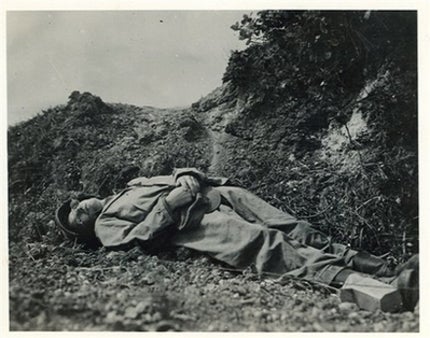Last Dispatch from Ernie Pyle
It is just a photograph of a body at the side of a road—another death among the millions of deaths of World War II. Yet this photo, long lost and never before published, has surprised historians. The dead man in the picture is Ernie Pyle, the famed war correspondent whose dispatches painted vivid portraits of the lives of common GIs.

It is just a photograph of a body at the side of a road—another death among the millions of deaths of World War II. Yet this photo, long lost and never before published, has surprised historians. The dead man in the picture is Ernie Pyle, the famed war correspondent whose dispatches painted vivid portraits of the lives of common GIs. Pyle famously covered several theaters of war, including the brutal Italian campaign of 1943-1944, and was killed on April 17, 1945 on the island of le Shima, off Okinawa in the Pacific.
Even historians who have specialized in studying Pyle’s work and collecting his correspondence had never seen the image. The negative is long lost and only a few prints were known to exist.
“When I think about the real treasures of American history that we have,” says Mark Foynes, director of the Wright Museum of World War II in Wolfeboro, N.H., “this picture is definitely in the ballpark.”
The impact of Pyle’s war coverage is hard to imagine from a modern perspective. American civilians and soldiers cried when they heard the news that he had been killed by a Japanese machine gunner while riding in a Jeep with three officers. An army photographer, Alexander Roberts, crept forward in the dirt with his Speed Graphic to make the image. He withheld it from publication, “out of decency.”
Pyle himself often felt the same emotion about the dead he saw far too often. In Rick Atkinson’s recently published history of the Italian campaign, “The Day of Battle” (Henry Holt), he tells of Pyle watching as soldiers with pack mules brought back from the front a number of bodies, including Captain Henry T. Waskow, a native of Texas. Pyle watched and said nothing, writes Atkinson. “You feel small in the presence of dead men, and you don’t ask silly questions,” Pyle later explained. Later, Pyle described in a dispatch the scene that day. War reporting has never been better.
The lost photo of Pyle approaches such depth of feeling. “It’s a striking and painful image, but Ernie Pyle wanted people to see and understand the sacrifices that soldiers had to make, so it’s fitting, in a way, that this photo of his own death … drives home the reality and the finality of that sacrifice,” said James E. Tobin, a professor at Miami University of Ohio.